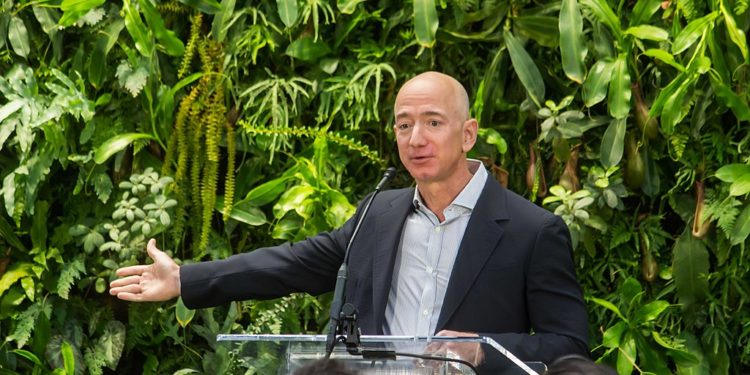Amazon’s Ad Blitz Supporting the $15 Minimum Wage Is Admirable, But It Can Do More

Over the last few weeks, my morning ritual of reading too many business, finance, and policy newsletters has been inundated with a new content type – scores of promoted posts and sponsored content from Amazon touting that, “It’s time to pass the Raise the Wage Act.”
As a marketer, I’ve been impressed with the scale and consistency of the promotion. It’s a full court press during a critical juncture for worker wages in America. For far too long workers have not shared in the prosperity of American capitalism. An editorial penned last week in Yahoo Finance by Ursula Burns, Lynn Forester de Rothschild, Leo Strine, and Darren Walker reminded us: “For the past 40 years, worker productivity increased 70%, the S&P 500 grew more than 700% in value, CEO compensation skyrocketed by 940%, but the hourly wages for average workers rose by only 12%.”
Our own research at JUST Capital shows that even before the coronavirus pandemic hit the country, 50% of workers at Russell 1000 companies weren’t making enough to support a family of three, even with a partner working part-time. That’s roughly 10 million workers that are not able to make ends meet, while working for the largest public U.S companies.
The economic, health, and social crises of 2020 further exposed the long-standing inequities in our society. Women, communities of color, and low-wage workers have borne the brunt of the crises as they make up a disproportionate share of our low-wage workforce. Many are the new essential workers who have continued to put their lives on the line to keep our economy going.
The time is now for our business leaders to think differently about how they are supporting their lowest paid workers. If we are going to “build back better” on the other side of these crises, business needs to put workers at the heart of the transformation. We need to shift mindsets away from treating workers as costs, and instead recognize workers as an investment. Why? Because research shows that investing in worker wages and benefits has a positive impact on recruitment, productivity, engagement, retention, and customer satisfaction, as well as society overall.
Amazon’s Senior Vice President of Global Corporate Affairs, Jay Carney, posted an article that links from those aforementioned ads. In it, he shares: “Once we increased our starting wage to $15 an hour, the positive impact on employee morale and retention – and the surge in job applicants – was immediate. In fact, the month after we raised our starting wage, applications for hourly positions more than doubled. Employees who saw their paychecks increase told us that they had an easier time providing for their families and were able to spend on things like car repairs and home improvement projects. In short, the investments we made in our hourly employees were quickly transferred to local businesses and economies.”
That decision he referred to also had a peer pressure effect, with retailers like Target, Best Buy, and Costco also increasing wages. It’s great to see Amazon recognize the connection between wages and productivity as it’s a crucial step towards creating an economy that works for all Americans.
The Wall Street Journal further fueled the business case that paying workers more can boost the bottom line in “How Higher Wages Can Increase Profits” by Ray Fisman and Michael Luca. The piece focuses on some new research from Harvard that examines the connection between wages and productivity among warehouse workers at an anonymous Fortune 500 online retailer that raised wages from $16 to $18. The key takeaway: “Prior to the increase, employees moved an average of 4.92 boxes per hour. A $1 pay increase boosted this figure by a third of a box. Higher wages also led to a large drop in employee turnover: a $1 increase reduced the quit rate by 19%.” The increased pay not only improved workers’ lives, it more than paid for itself via improved productivity and reduced costs by not having to hire and train new employees. The study found similar productivity and turnover improvements when wages were raised for the company’s customer service representatives as well.
So what’s my issue then with Amazon pushing for a $15 minimum wage? American workers need a living wage, not a minimum one – beautifully summarized by opinion columnists’ Nir Kaissar and Timothy L. O’Brien in Bloomberg. As the second largest employer in the country, with the second richest CEO in the world, Amazon is one of the most scrutinized and most influential companies, so their stance matters.
Here at JUST Capital, we’ve been working with Amy Glasmeir at MIT for the last several years, as “paying a fair and livable wage” is the top issue Americans care about most when it comes to just business behavior, and we’ve leveraged her Living Wage Calculator to identify the living wage threshold in different locations across the country. A living wage is defined as the amount of money needed to cover the local cost of basic necessities – food, childcare, health insurance, housing, transportation, and other basic necessities (like clothing) – for a given family size. And the living wage varies by location: In Pittsburgh, for example, a single working parent with one child needs to earn $23.59 per hour (or roughly $49,070 a year) to cover their basic expenses. In Lawrence County – a rural county near Pittsburgh – a single working parent with one child needs to earn $20.91 per hour (or roughly $43,493 a year) to cover their basic expenses.
For a more visceral example, a customer service representative from PayPal explains in this Business Insider article that he used to sell his plasma a couple times a month to help pay his bills before the company made the decision to lift wages and benefits for its hourly workers. Before the increase, the $16.75 average wage for his role in Omaha was well above the state’s minimum wage, and market rate for his role, but was also well below the living wage for a sole provider in the area.
That’s why we’ve teamed up with PayPal, the Financial Health Network, and the Good Jobs Institute to make workers’ financial health and security a C-suite and investor priority. Our Worker Financial Wellness Initiative asks CEOs to consider whether their employees are able to make ends meet after paying for necessities, and provides the tools to assess workers’ financial health and security.
The first step for any corporate leader is to ask a new set of questions about their workers’ lives and livelihoods, “Are they running out of money between paychecks? Are they able to pay for health insurance? Are they able to get the hours they need to provide for their family? Are they able to save for their retirement and the future? As Adam Grant explores in his new book, “Think Again: The Power of Knowing What You Don’t Know,” we need our leaders to be humble about what information they might not have in hand today, and curious about seeking new answers. This exploration should be a priority for C-suite leaders and boards not simply because it’s the right thing to do if you care about addressing income inequality or advancing racial and gender equity, but because it’s an investment in the bottom line and future growth. It’s smart business. And it can help improve tens of millions of lives.
If you have questions or would like to get involved in the Worker Financial Wellness Initiative, please get in touch. We’d be delighted to help you and your company get started on a confidential assessment of the financial health of your workers, including specifically how many workers are/are not making a living wage across the country.






